Menu
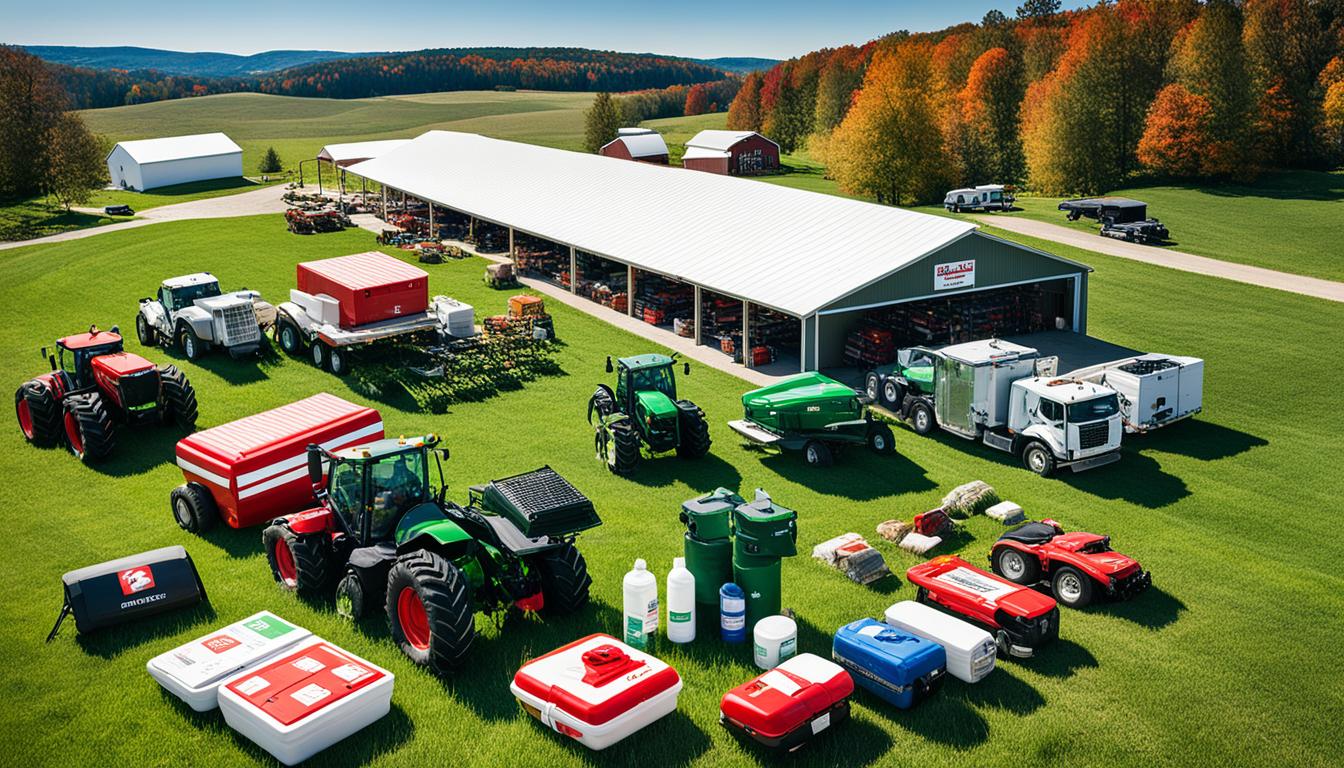
Did you know that over 16% of American farms face big harm from natural disasters each year? This shows how vital preparing for emergencies is. By finding good ways to handle crises, rural areas fight the effects of climate change and severe weather. This helps them protect their farms and become stronger against future challenges.
Learning from real cases is key in figuring out how farming communities should get ready for and face natural disasters. Take the Nebraska floods or the California wildfires, for example. These events showed us a lot about the best ways to protect farming. The ways these communities responded, and the methods they used to stay strong, can guide others in planning for emergencies.
In agriculture, natural disasters like floods, hurricanes, and wildfires are big threats. They endanger lives, land, and jobs. Being ready is key to protecting rural areas from severe weather events.
Natural disasters are extreme weather events that hit rural areas hard. They can be floods, hurricanes, and more. These events are happening more often because of climate change, which makes rural life riskier.
Being ready is crucial to lessen natural disasters’ impact on farms. Having a solid plan helps communities respond quickly and well. Good plans have strong communication, work with emergency groups, and personal prep like having enough food and medicine.
The importance of farm disaster response analysis and making agricultural incident readiness reports is huge. These documents check if plans are good and spot areas needing work. They make sure help, evacuation plans, and teamwork are all in order.
Caring for mental health after disasters is also key. Natural catastrophes can deeply affect people. Tending to emotional health helps rural places bounce back and stand strong again.
| Preparedness Initiative | Key Aspects | Examples |
|---|---|---|
| Emergency Action Plans | Communication, Evacuation, Supplies | Coordination with Farms, Local Services |
| Community Engagement | Post-Disaster Recovery, Resilience Building | Volunteer Management, Mental Health Support |
| Environmental Understanding | Local Watersheds, Natural Systems | Mitigation, Future Preparedness |
To sum up, farm disaster response analysis and agricultural incident readiness reports are crucial. They guide good preparation. This ensures that rural communities are ready for tough times brought by natural disasters.
Climate change is making extreme weather events more common and stronger. This change is affecting farming, buildings, and people’s health in rural places.
The Southeast United States is seeing more and more extreme weather because of climate change. Nearly 20 percent of this area’s population lives in rural parts. Rising temperatures are hurting how much work can get done and affecting people’s health.
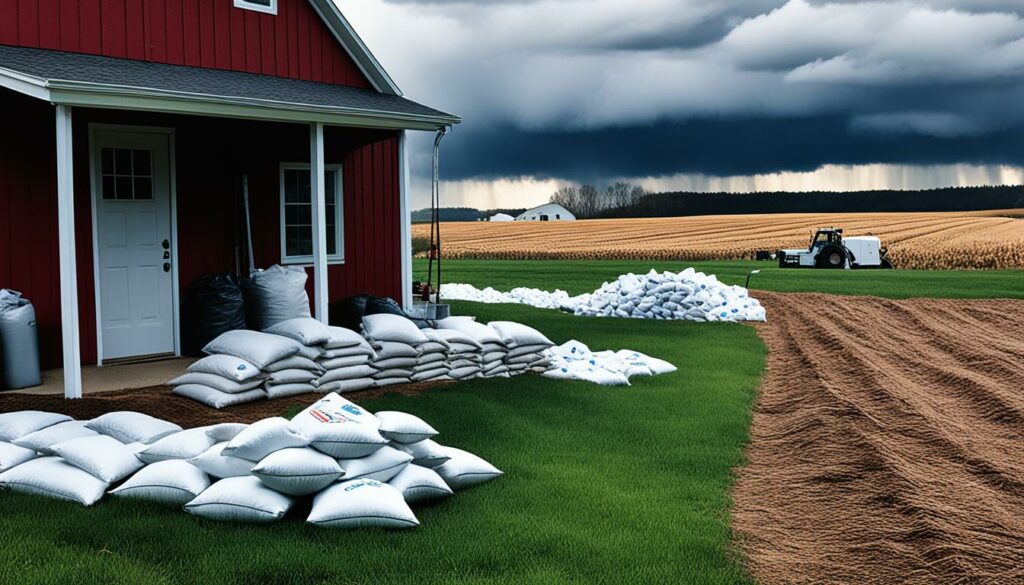
In this region, forests cover almost 50 to 80 percent of the land. Pine farming is common, but it harms the land’s ability to recover. Sadly, six states in this area have high rates of people dying from heat while working. If we don’t cut carbon emissions, the Southeast will see the biggest drop in work productivity due to heat by 2090 in the US.
The Southeast’s rural areas have economy diversity but face ongoing poverty. More than a third of these areas have had high poverty for decades. They also see a lot of people leaving and have low education levels. This makes them more at risk from the effects of climate change. Efforts are being made to lower these risks, especially for health.
Agricultural work is tough, and workers face a higher risk of heat-related deaths. This high risk shows a need for better emergency plans in rural areas. Lyme disease cases jumped by 357% from 2007 to 2021.
Florida studies found that 81% of farm workers were dehydrated after work and 33% had kidney problems. In North Carolina, rural areas see more heat-related sickness than cities, especially in young adults. Plus, these areas don’t have enough doctors.
Many rural hospitals have closed since 2005, and flooding is a big health risk. It can lead to breathing issues, stress, and mental health problems. More pests are also spreading diseases, adding to the health dangers. So, the impact of climate change on rural areas is a big worry.
Flooding is a huge problem for rural areas and farms. It comes in different forms like river, flash, or coastal flooding. Each type can badly affect farming both now and later.
Riverine floods overflow from heavy rain or melting snow. They cover farms with water, which can be devastating. Flash floods happen fast after heavy rain, often washing away fields and crops. This leaves a lot of damage behind. Coastal flooding happens near the sea when storm surges push water inland. It can make the soil too salty for growing crops.
Flooding brings health problems and hurts farm structures. Stagnant water makes a perfect place for bacteria and mold to grow. This can cause diseases and breathing problems. Using generators wrong can lead to carbon monoxide poisoning.
Floods also ruin important farm roads, bridges, and irrigation systems. The best way to fight these problems is by being ready. Agricultural resilience planning and good emergency plans can make a big difference. It’s also wise to look at stories from past floods, like those from the Champhone district. This helps communities plan better for floods.
| Aspect | Impact | Mitigation Strategy |
|---|---|---|
| Soil Erosion | Loss of fertile topsoil | Planting cover crops to protect soil |
| Infrastructure Damage | Destruction of roads, bridges | Enhancing foundation designs |
| Health Risks | Waterborne diseases, mold | Implementing proper sanitation |
Learning from stories in places like the Champhone district helps a lot. It shows how to plan for and fight against floods. With better plans, we can keep farming and our communities safe.
After natural disasters, farms often face big damages. Hurricanes are especially tough, needing strong plans to protect farms and buildings. It’s key to study how to get ready for emergencies and use this knowledge locally.
Good strategies for hurricanes start with knowing what’s coming and planning how to leave safely. We’re getting better at predicting storms thanks to technology. This gives farmers more time to get ready.
Knowing the best ways to get out, what to bring, and keeping animals safe are crucial. These things should all be in a farm’s disaster plan. This helps cut down on damage.
Hurricanes can cause huge harm to farms, as seen from a flood in Eastern Nebraska. It caused over $2.6 billion in damage. Looking at what worked in the past can teach us how to recover better. For example, making buildings stronger against storms and planning evacuations can help.

Structures should be made stronger, and animals might need to move to stay safe. It’s very important to respond quickly to hurricanes. This helps lower the damage and speeds up recovery after the storm.
Learning from past storms and updating plans helps farms stay strong against future hurricanes. This can protect farmers’ incomes and their way of life.
| Natural Hazard | Impact | Recovery Strategies |
|---|---|---|
| Bomb Cyclone Flood | $2.6 billion damage statewide | Operational adjustments, technology integration |
| August Complex Wildfire | Nearly 1 million acres burned | Fireproofing, community drills |
| Hurricanes | Widespread destruction of crops and infrastructure | Evacuation planning, structural reinforcement |
Studying farm emergency cases and ways to deal with hurricanes helps us make good plans. Being ready and able to change plans quickly helps protect farms. This keeps our food sources safe for the future.
It’s crucial to know the fire risks for farming to fight wildfires well. This part talks about how to deal with wildfires in the community and on farms. It’s all about being ready and acting before a fire starts.
The Marshall Fire in Colorado on December 30, 2021, was a wake-up call. It was the worst fire the state had ever seen. It showed how homes near wild areas can be at risk. Fires can happen from spring to fall, and even longer some years. So, we must know what causes fires and how to stop them.
The Federal Emergency Management Agency (FEMA) visited after the Marshall Fire. They looked at how buildings hold up and if communities were ready for fires. To help make places safer, there’s a toolbox with the best ideas for beating fires. It’s called the Community Wildfire Mitigation Best Practices toolbox. It’s for anyone in charge of keeping areas safe from fires.
Stopping fires needs both local work and farm plans. Good relationships and working together are key. People who fight fires say we should aim at the most dangerous areas. Also, it’s about making strong teams and getting results, not just doing things.
Here’s a look at how stopping fires is different for communities and farms:
| Aspect | Community-Based Fire Prevention | Farm-Level Mitigation |
|---|---|---|
| Preparedness | Training locals, running fire drills, and making escape plans. | Teaching workers, making sure there’s water, and keeping firebreaks clear. |
| Resources | Tools for the community, money help, and letting people know about fire risks. | Buying things that don’t burn easily, having fire gear ready, and getting insurance. |
| Leadership | Local leaders and fire experts leading efforts, giving advice. | Owners and managers of farms making plans that fit their land. |
Cleaning up forests, controlled burns, and using machines can lower fire danger a lot. It’s good to have rules and tools for safety, like plans for when things go wrong.
Good leadership makes fighting fires easier. It helps keep everyone working hard and breaking down problems. Sharing knowledge and making sure everyone is ready to act fast is very important. Together, communities and farms can fight fires, keeping people safe and their homes secure.
Drought often gets less attention in disaster planning. It’s because it happens slowly and its effects aren’t obvious at first. This makes it hard to spot as an emergency.
Drought’s impact on people and nature appears slowly. It mainly hurts crops and animals, which makes it tough to measure without deep studies. The real shortage of food shows up many months after the drought starts.
Experts predict more and worse droughts worldwide. This means we should stop dealing with the problem once it’s there, and start planning from the start. Having strong plans for drought involves making our organisations able to cope and giving timely info to top decision-makers.
Drills and simulations are key for making this work, showing where we might fail to talk or work together. By watching these drills, we see how to deal with the many parts of responding to a crisis. This makes us better prepared and helps us check how well we can work together without spending a lot.
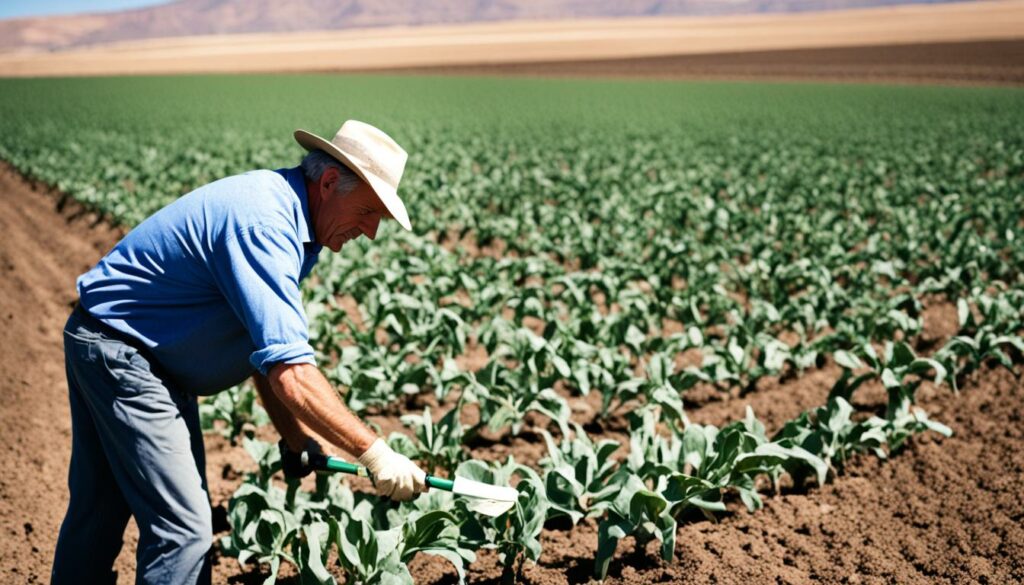
India is very open to drought disasters, with over 68% of its farming land at risk. For example, in 2016, 300 areas were desperate for drinking water. In another case, in 2015-16, 46 out of 51 districts in Madhya Pradesh were in drought, hitting nearly 43,000 villages.
We can lessen drought’s blow by being ready in advance. This includes keeping an eye on the weather and improving how we react in order to be stronger when slow disasters come. Doing exercises with different groups helps us all learn and think about how to handle hard times better.
| Region | Year | Affected Areas | Remarks |
|---|---|---|---|
| Madhya Pradesh | 2015-16 | 46 districts | Declared drought-hit; proactive measures needed |
| India | 2016 | 300 districts | Acute drinking water shortage |
| India | 2018 | 91 reservoirs | Water capacity at 25% |
Creating a detailed emergency action plan is vital for farms. It helps lessen the impact of disasters. These plans protect livestock, crops, and farm buildings. They also keep the nearby rural community safe.
An effective emergency action planning strategy includes vital elements for crisis management. It identifies where to shut off water and electricity. This knowledge is crucial to avoid more harm in emergencies. It can help prevent financial losses and injury.
Such a plan needs up-to-date contact info for emergency teams and neighbours. Fast communication with them is key. It ensures quick access to help and resources. Also, it’s important to list the emergency tools and equipment available.
It’s essential to include plans for disposing of animal carcasses. This is for times when many animals die from disease or a natural disaster. Using professionals for disposal helps prevent the spread of health issues.
| Component | Description |
|---|---|
| Water & Electric Shutoffs | Essential for damage control during emergencies. |
| Contact Information | Includes details of emergency response agencies and neighbours for coordination. |
| Emergency Equipment List | Ensures prompt response and access to necessary tools. |
| Carcass Disposal | Methdos such as rendering or landfills to manage massive deaths. |
Preventing risks is also key. Before storms, avoid spreading waste. And stop waste runoff by creating diverts. These actions lower the disaster risks.
Effective rural emergency coordination relies on good communication and teamwork. Rural areas often have scarce resources and issues with communication. So, working together is vital. Sharing resources and regular training drills with emergency services boost community readiness.
Rural emergency teams often depend on volunteers. But, to keep a good team, it’s crucial to train and retain these volunteers. The Institute for Rural Emergency Management (IREM) helps with this. It offers advice and support to improve emergency response in the countryside.
The key is a well-developed emergency plan and strong community support. This, along with sound resource management, enhances the ability of farms and rural areas to handle disasters.
I’ve looked at serious incidents to show good farm emergency plans. These studies give clear examples of how to handle agriculture crises. They talk about preparing ahead, how communities can stay strong, and recovery after a disaster.
In March 2019, a bomb cyclone and fast snowmelt led to a huge flood in Eastern Nebraska. Farms were badly hit, affecting many rural areas. This event shows how forecasting weather is key to reacting early and lessening harm. Farmers used their plans, like knowing where to go when evacuating and having extra food for their animals, which helped a lot. This shows how being ready protects farms and keeps communities strong.
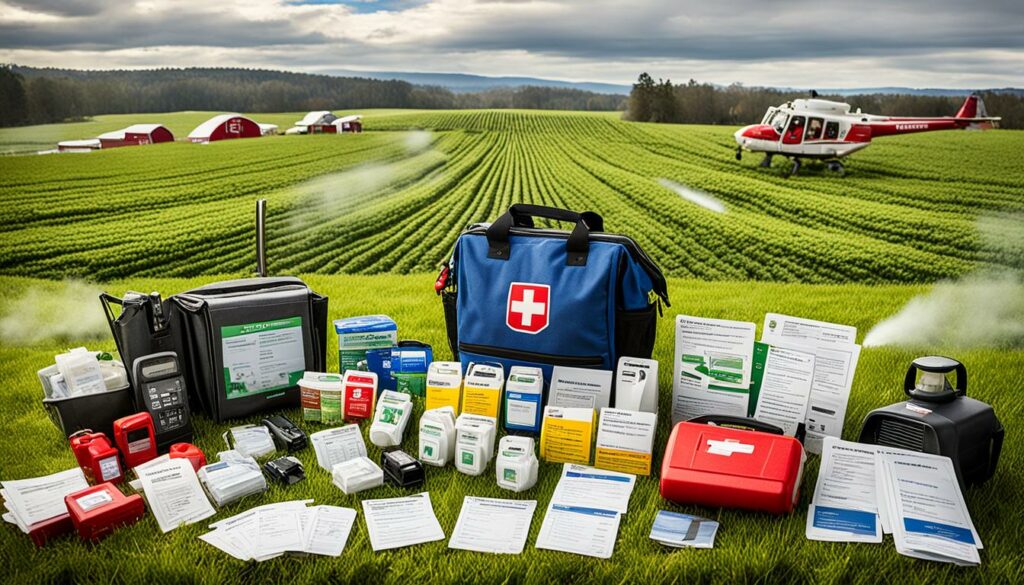
The August Complex fire in Northern California in 2020 was massive, burning almost 1 million acres and many buildings. This event stressed the need for strong emergency plans to keep people and animals safe. It was important to have fire tools ready and plans for moving things to safe areas. After the fire, the community worked together, showing how group efforts can bounce back from big challenges.
These cases prove that good emergency plans, based on studying past incidents, are key. They not only lessen immediate harm but also speed up recovery and improve future preparedness.
Drills and simulations are key in preparing for farming emergencies. They help with planning for crises like droughts. By testing strengths and spotting weaknesses, they make us better ready for disasters.
Simulations are vital because they mimic real events. They let people in farming try out solutions and get better at them. Droughts are slow to appear and need special preparation. These works are vital for lessening harm and managing risks early.
“Drills improve team efforts and show us where to get better,” cites a study on farming crisis simulations. It talks about moving from just reacting to planning ahead. It advises on doing drills together to learn fully and improve fast.
In Guatemala, drills have shown their worth in managing droughts. As droughts may happen more, focusing on how to cope is key. Guatemala’s lessons highlight how drills find weaknesses and build strong plans.
| Aspect | Details |
|---|---|
| Disaster Type | Drought |
| Main Impacts | Losses in harvests and livestock, severe knock-on effects on food availability |
| Response | Enhanced inter-institutional communication, coordination, and planning through tabletop exercises |
| Outcome | Improved preparedness and ability to avert real-time failures |
Using exercises and games, experts watch how officials react in crisis practice. This helps in checking and improving crisis handling. Watching real-time actions offers a look into how good institutions are at facing disasters.
“Watching responses live during drills is key in finding what’s good and what can be better in dealing with disasters,” remarks a review of practice exercises.
To wrap up, using drills and exercises is a great way to increase farm disaster coping. They are especially helpful in places that are at risk of slow-appearing emergencies. More focus on these drills means quicker warning for those in charge, making the farming world stronger against disasters.
Being ready for emergencies is key for farmers to protect their way of life. It helps them bounce back from tough times. Preparation includes gathering supplies, keeping animals and plants safe, and having extra power ready.
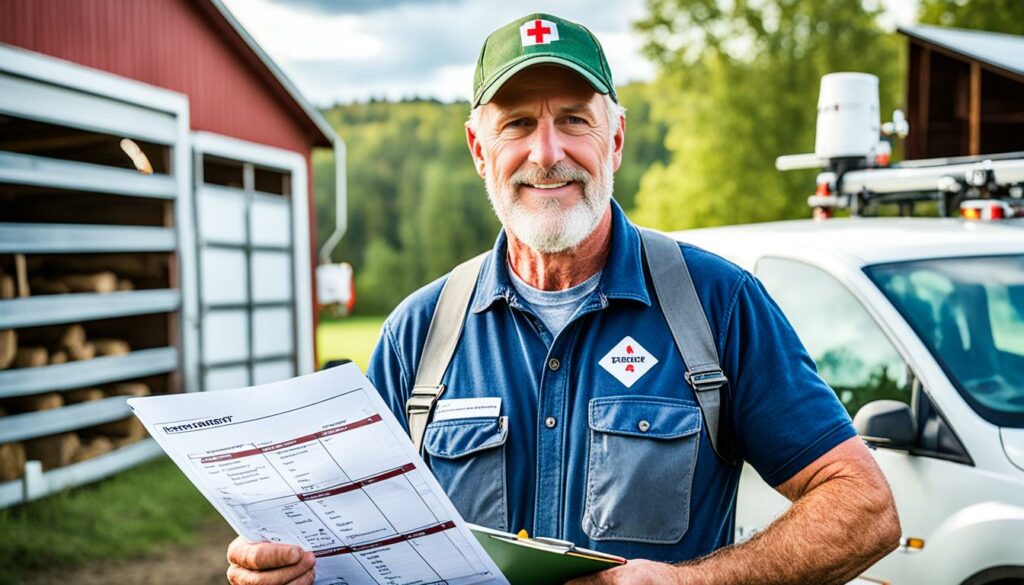
Farmers first focus on getting important supplies and tools for emergencies. This means lots of food and water, plenty of medical items, and backup power are crucial. The need for this was clear during big events like the August Complex fire in Northern California and the storm in North Bend, Nebraska, which did huge damage. These show the huge difference being ready can make.
Preparation also means making detailed plans for animals and plants. It’s about making sure animals have a safe place and plants are looked after. Farmers should check what buildings and materials they have, and work closely with emergency services. This is very important because natural disasters can lead to unseen dangers like carbon monoxide.
Tackling emergencies together with the local community boosts farmers’ ability to respond to disasters. This team effort not only makes farms safer but keeps the whole farming community stronger and more sustainable.
To prepare for natural disasters, rural communities should develop emergency action plans, ensure continued communication with residents, and provide equipment and resources like generators for critical service providers.
In 1998, the northeastern U.S. was hit by a severe ice storm. It showed how crucial it is for rural emergency services to work closely with farms. The storm highlighted the big need for farming to have electrical generators.
Farmers who had generators were able to handle emergencies better. But those without faced harsh outcomes. This points out the value of rural areas and emergency services working together.
Fire and rescue services play a key part during farm emergencies. They don’t just keep people safe but also protect farm animals and buildings. They help in many situations, from small fires in barns to big flooding.
If a fire breaks out, these teams are vital. They save animals, stop the fire from spreading, and protect farmland. In floods, they help to move people and animals to safe places.
Veterinarians are essential in farm emergency plans. Having them on these teams can stop diseases like Foot and Mouth or Swine Fever. This is critical to keep our food supply safe and trades running smoothly. During crises, these experts help control diseases, look after animal health, and handle dead bodies properly.
Quick veterinary responses can prevent bigger problems. This is why emergency managers have categories for various crises. They know that fitting responses to the size of the issue is key. Working closely with local veterinarians speeds up and improves these efforts. It makes the job easier for everyone involved.
The teamwork between rural services and veterinarians is vital. This is proven by studying U.S. recovery plans after disasters. It highlights the need for new, smart ways to bounce back and keep farms strong.
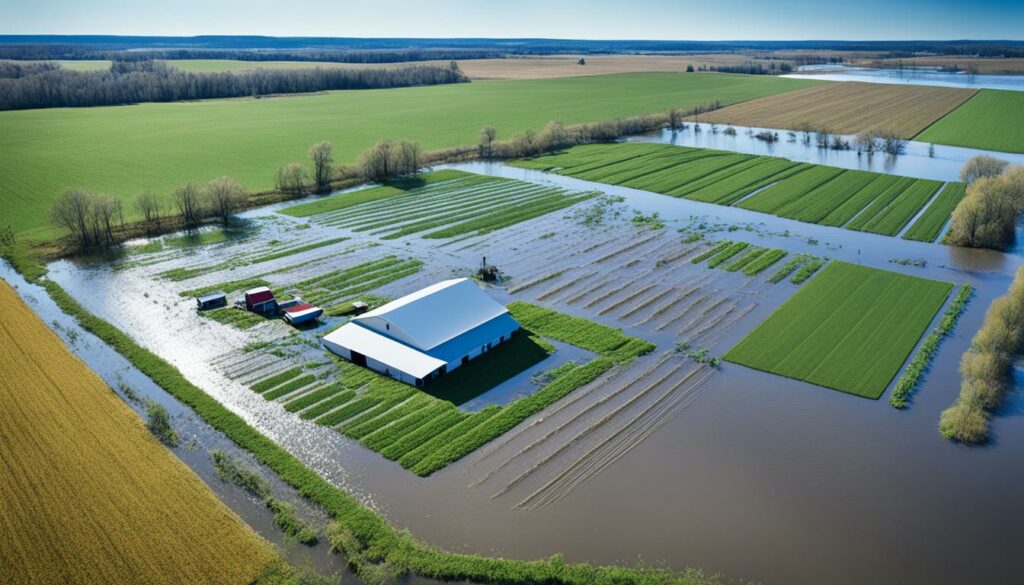
Disasters hit rural areas suddenly, causing chaos on farms. Recovery relies on strong community tie-ups and managing volunteers well. With everyone working together, farms can get back on their feet quicker after any disaster.
Recovering from disasters on farms is all about community spirit. Local groups and volunteers are crucial for early help and getting things back to normal. They help give out resources, assist directly, and support where professional help is slow.
This includes coordinating among farmers and leaders to use resources smartly. This helps especially when different disasters, such as floods or wildfires, affect different areas greatly.
Rebuilding after disasters isn’t just about the physical. The mental health of those involved is critical. Events like tornadoes and wildfires can leave deep psychological scars.
Providing mental health care is key to recovery. It’s vital that mental well-being is cared for as physical areas are fixed. Experts should be part of disaster plans to help people cope.
Improving these areas is vital for better farm disaster recoveries. It’s all about not just fixing, but helping rural places thrive after the worst.
When it comes to being ready for farm emergencies, looking at the environment is key. Things like floods, hurricanes, and fires can change the farm land a lot. Knowing about the area’s environment helps us get ready for these big events.
Knowing the local watersheds is very important. They affect how water moves, which can cause floods. By understanding this, farmers can predict flood areas. This helps them make plans to manage floods better and protect their farms.
Thinking about how the land is used is crucial in emergency plans. Building and changing the land can mess up natural water flow and hurt habitats. This can make disasters worse. Planning smartly can help farmers keep their farms safe while not harming nature as much.
Farmers can deal with nature’s challenges better by adding these points to their emergency plans. Checking and changing these plans is critical for keeping farms strong and sustainable over time.
Farm emergency readiness means facing lots of different challenges. But, rural areas have shown they can bounce back well. With climate change leading to more natural disasters, farms must have strong plans in place. These plans help keep things like buildings, jobs, and people safe. They also help make sure the countryside can keep thriving.
Our study and real-life examples from places like Palm Beach and Polk in Florida show how important it is to plan ahead. Good emergency prep for farms includes knowing the area well to lessen disaster effects. It also means having your own supplies for emergencies and dealing with health dangers. For instance, the August Complex fire in California was a big event that harmed a lot of farming areas and gear.
It’s key for farms to work closely with local emergency teams. Quick help is harder to get in far-off places. Also, it’s really important to look out for people’s mental health after a disaster. Making sure there’s enough food and dealing with money issues are also big parts of recovery. Our advice is to always be ready and learn from the past. This way, rural areas can be stronger when another emergency happens.
Being ready for emergencies in farming predicts disasters. This helps in quick responses and lessening the blow on crops and animals. It protects everyone’s livelihoods and health in the countryside.
Climate change brings more extreme weather events, like floods and fires. These events are dangerous for farms and the people living there. They can harm crops, break buildings, and spread diseases.
Two main types of floods, riverine and flash floods, can ruin farmland. They cause soil to wash away, break buildings, and spread waterborne diseases. Good plans and quick reactions are key to deal with these.
For hurricanes, knowing what’s coming and having a plan to leave are very important for farm safety. These steps help protect farms and keep people safe with a well-organised response.
To lessen wildfire damage, farms should understand the fire danger and be ready to prevent and fight fires. This means checking how prepared the farm is, gathering firefighting tools, and knowing how to use them well.
Learning from successful drought management cases can improve how we deal with droughts. These success stories show better farming methods, keeping an eye on weather, and how to get help from organisations. They help farms stay strong against slow disasters.
A good plan for farm emergencies should cover how to talk to each other, where to get help, and where to go if you need to leave. It’s important to plan with others, so everyone knows what to do in an emergency.
Two real-life stories, one from Nebraska’s floods and another from California’s wildfires, show how being ready helps. They point out how important it is to plan ahead, work together as a community, and recover well after bad times.
Practising with drills shows what needs to improve and how to get better prepared. This is key for dealing with slow-disasters like droughts. The case study from Guatemala on drought prep is a great example of this.
Farmers should gather enough supplies, have a plan for when the power goes out, and keep their animals and crops safe. Everyone doing their part helps the farming community stay strong during disasters.
Working well with local emergency services, like fire and animal health experts, is vital. It ensures quick, skilled responses to disasters. This saves both people and animals in the countryside.
Getting the whole community involved in helping, and managing stress and trauma, is crucial after a disaster. This support is needed immediately and in the long run, for everyone affected.
Knowing how the local environment acts and reacts to changes is key in being ready for emergencies. This is because the environment can greatly change how bad a disaster gets and what it takes to overcome it on the farm.